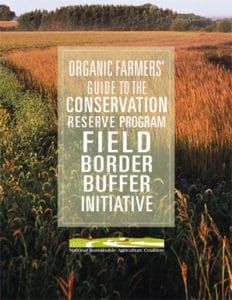 The National Sustainable Agriculture Coalition has released its Organic Farmers’ Guide to the Conservation Reserve Program Field Border Buffer Initiative. The guide is a free resource, one of many free guides the National Sustainable Agriculture Coalition regularly produces for farmers and farm groups, and for organic farmers interested in accessing the U.S. Department of Agriculture’s new Organic Buffer Initiative. Find it on this page.
The National Sustainable Agriculture Coalition has released its Organic Farmers’ Guide to the Conservation Reserve Program Field Border Buffer Initiative. The guide is a free resource, one of many free guides the National Sustainable Agriculture Coalition regularly produces for farmers and farm groups, and for organic farmers interested in accessing the U.S. Department of Agriculture’s new Organic Buffer Initiative. Find it on this page.
“Organic farming already provides many environmental benefits, including improved soil health and water quality,” said Greg Fogel, senior policy specialist with the National Sustainable Agriculture Coalition. “The Organic Buffer Initiative is a great new tool that will help organic farmers looking to take their conservation efforts to the next level, and we hope that our farmers’ guide will help them seamlessly access and utilize the program.”
The guide includes eligibility and application information, program basics, detailed descriptions of key conservation practices and associated payments, as well as two producer profiles and resources for additional information. The buffer initiative, which is administered by the Farm Service Agency as part of the Conservation Reserve Program’s Continuous Sign-up aims to establish up to 20,000 acres of new conservation buffers. Conservation buffers can come in many varieties, but are generally described as small areas or strips of land in permanent vegetation designed to slow runoff, provide shelter for wildlife and prevent erosion along riverbank areas.
Through the Organic Buffer Initiative the Farm Service Agency provides farmers with rental payments, cost-share payments and in many cases incentive payments for land that is set aside for conservation buffers for a period of 10 to 15 years. The initiative helps organic producers limit the impacts of pesticide drift, enhance conservation systems and meet National Organic Program certification requirements for natural resource and biodiversity conservation.
Eligible practices include riparian buffers, wildlife-habitat buffers, wetland buffers, filter strips, wetland restoration, grass waterways, shelter belts, windbreaks, living snow fences, contour grass strips, salt-tolerant vegetation and shallow water areas for wildlife.
Under the new organic initiative, farmers are free to use whichever eligible practice or suite of practices best suits their particular needs.
Visit http://sustainableagriculture.net for more information.

